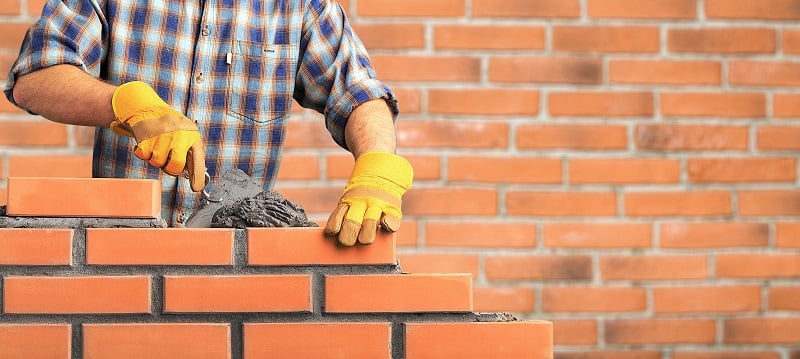Reliable Tuckpointing Services for Improving Brick and Rock Surfaces
Reliable Tuckpointing Services for Improving Brick and Rock Surfaces
Blog Article
Opening the Tricks of Sustainable Masonry Building Practices for Eco-Friendly Buildings
In the world of modern-day building and construction, the pursuit of sustainable methods has come to be extremely important. Among the myriad techniques to environmentally friendly structure, sustainable masonry building sticks out as a reliable and durable method that holds a riches of untapped capacity. From the option of materials to cutting-edge building methods, the tricks to attaining sustainability within masonry construction are diverse and interesting. By discovering the advantages, products, strategies, and future trends of sustainable masonry, a much deeper understanding of just how these techniques can form the future of green buildings arises.
Advantages of Lasting Stonework Building
Accepting sustainable masonry construction techniques not just lowers ecological effect yet additionally uses lasting financial benefits to contractors and neighborhoods. By utilizing materials like recycled blocks, obstructs, and rocks, home builders can significantly lower the carbon impact of their tasks while promoting source performance. Furthermore, lasting stonework building methods, such as appropriate insulation and thermal mass properties, can enhance energy performance within structures, bring about lowered functional costs with time.
Additionally, the toughness and resilience of stonework structures add to long-lasting financial advantages. Buildings created utilizing lasting masonry practices commonly need much less maintenance and fixing, equating to set you back financial savings for building contractors and property owners. The durability of masonry materials likewise guarantees that frameworks stay stable and safe, decreasing the demand for regular renovations or substitutes.
Eco-Friendly Masonry Materials
Making use of eco-friendly stonework products is an essential action towards enhancing the sustainability of construction techniques and decreasing ecological effect while optimizing long-lasting financial benefits. Sustainable stonework materials are sourced, generated, and used in a way that decreases overall ecological influence. Lasting concrete blocks include recycled accumulations and might feature better insulation buildings, adding to energy efficiency in structures.
Moreover, natural products like adobe, rammed planet, and straw bales provide superb thermal mass buildings, minimizing the need for home heating and cooling power. These materials are often in your area available, advertising regional economic situations and minimizing transportation-related carbon emissions. By choosing environmentally friendly stonework materials, building and construction jobs can significantly minimize their environmental footprint and add to the development of much healthier, much more lasting built settings.
Energy-Efficient Masonry Strategies
Power efficiency plays an important function in boosting the sustainability of stonework construction practices. One essential energy-efficient stonework method is the usage of thermal mass, which entails including thick products like concrete or block right into the structure's framework to soak up and save warmth.

Developments in Sustainable Masonry
Recent advancements in sustainable masonry practices have actually brought around ingenious techniques that are reshaping the building and construction market. One such development is the development of self-healing concrete, which utilizes bacteria installed within the concrete to recover fractures autonomously. This breakthrough not only lowers maintenance prices but likewise enhances the longevity of masonry frameworks, adding to their sustainability.
One more remarkable innovation is making use of stamped concrete floors indoors recycled accumulations in masonry building - masonry contractor. By incorporating materials such as crushed ceramic waste or recycled glass right into concrete blends, contractors can lower the additional resources environmental impact of building and construction tasks while maintaining structural honesty. This practice not only diverts waste from garbage dumps yet also saves natural deposits, making it a key development in lasting stonework construction
Moreover, the assimilation of electronic style devices, such as Structure Details Modeling (BIM), is reinventing the way masonry frameworks are intended and constructed. BIM enables even more precise estimations, reduced material wastefulness, and improved energy effectiveness, inevitably leading to more sustainable structure techniques. These developments collectively symbolize an encouraging future for sustainable masonry building in the period of environmentally friendly structures.
Future Trends in Masonry Sustainability
With the innovative strides made in sustainable masonry practices, the future trends in masonry sustainability are positioned to additional change the building sector. One of the essential trends shaping the future of masonry sustainability is the increased assimilation of innovation. Improvements such as Structure Info Modeling (BIM) and online reality simulations are being utilized to maximize stonework building processes, leading to lowered product waste and improved power effectiveness in buildings.
Furthermore, the growth of novel sustainable products is established to play a considerable role in Clicking Here boosting the eco-friendliness of masonry building and construction. masonry contractor. Technologies like self-healing concrete, recycled aggregates, and bio-based binders are gaining grip for their ability to decrease environmental impact while preserving structural honesty

Conclusion
In conclusion, lasting stonework building and construction practices offer numerous benefits for environment-friendly structures. masonry contractor. Technologies in lasting stonework are continually being created to further improve the ecological efficiency of buildings.
Report this page